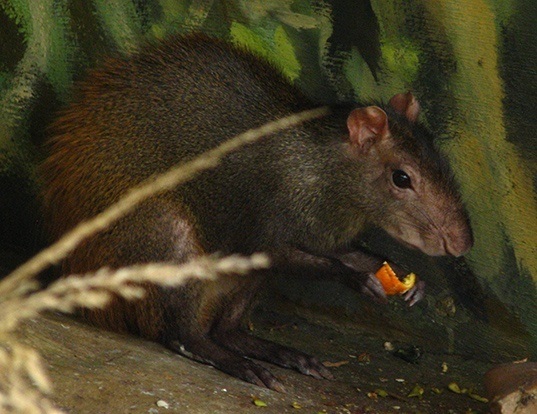

Nearly a third of it is dedicated to the animal's four, large incisors. Scientists have found that the somatosensory cortex, which is involved in the sense of touch, is unusually large. They also behaviorally thermoregulate by basking as needed in their shallow surface tunnels, which are warmed by the sun. By huddling together in large masses, they slow their rate of heat loss. Their temperatures fluctuate with the ambient temperature, making naked mole-rats essentially cold blooded. Unlike most other mammals, they cannot maintain a steady body temperature. These eusocial rodents also cooperate to thermoregulate. Mole-rats seem to do the majority of a year's digging just after the rainy season, when the normally hard ground is softened. They work assembly-line style: the front animals break through the dirt while a string of workers sweeps the soil through the tunnel system to an opening at the surface, where another worker kicks the dirt up onto the ground above its head, forming a mole hill. Their lips actually close behind their incisors, enabling them to dig without getting dirt in their mouths. Workers dig through the hard-packed soil with their powerful, ever-growing incisors, aided by the fact that a quarter of an individual's muscle mass is involved in jaw closure. Burrowing is the only way these animals find food, because they do not travel above ground. Tunnels connect nest chambers, toilet areas and food sources. There is a great deal of branching and interconnection of tunnels, with the result that a colony's total tunnel length can total up to 2.5 miles (4 kilometers). Some tunnels run just under the surface of the ground, while others can be up to 6.5 feet (2 meters) deep. The tunnels are about 1.5 inches (4 centimeters) in diameter. Naked mole-rats live in complex underground burrow systems. If a queen dies or is removed from a colony, a few females may fight to the death in order to become the new queen. Dispersal is quite rare and inbreeding is common, which results in a high degree of genetic similarity among colony members. Workers are generally raising their siblings, because a single queen may reign for many years. The animals in these groups are very closely related. Colony size averages 70 individuals, but colonies of up to 295 have been observed. This is an unusual characteristic for mammals. The red-rumped agouti with four pairs of larger salivary glands may be a model for studies concerning the anatomical changes in rodents for adaptation to various habitats.Naked mole-rats are eusocial, meaning they live in large colonies in which only one female breeds and the majority of workers (both males and females) spend their entire lives working for the colony.

With exception of the strictly serous parotid glands, the others were mixed, and only the mandibular glands had granulous ducts. The tubuloacinar glands contained in their parenchyma ducts of extremely varied sizes. Four larger salivary glands were identified: parotid glands, mandibular glands, zygomatic glands and sublingual glands.

leporina were used to study the macroscopic aspect of the glands, as well as the microscopic aspects with light microscopy, scanning and transmission electronic microscopy. Thus, this paper aimed to gross and microscopic description of the larger salivary glands of red-rumped agouti. Studies about the morphology of the red-rumped agouti, Dasyprocta leporina, approach the various organic systems, but not a single study refers to topography and structure arrangement of their salivary glands. E-mail: on wild animal morphology serve as theoretical basis for the management and conservation of different species, because they provide necessary information for measures to keep these animals in captivity, in their natural habitat or even to reintroduce them into their original habitat. Departamento de Ciências Animais, Universidade Federal Rural do Semi-Árido, Avenida Francisco Mota 572, Costa e Silva, Mossoró, RN 59625-900, Brazil. Morfologia das glândulas salivares maiores em cutias (Dasyprocta leporina Linnaeus, 1766). & Oliveira M.F.ĪBSTRACT.- Oliveira Júnior C.M., Bezerra F.V.F., Câmara F.V., Vale A.M., Oliveira G.B., Silva A.R., Ambrosio C.E. Oliveira Júnior C.M., Bezerra F.V.F., Câmara F.V., Vale A.M., Oliveira G.B., Silva A.R., Ambrosio C.E.


 0 kommentar(er)
0 kommentar(er)
